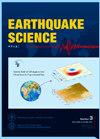断层摩擦的滑移率、状态、温度和正应力依赖性
IF 4.1
4区 地球科学
Q3 Earth and Planetary Sciences
引用次数: 0
摘要
慢滑事件和地震的机制受活动断裂带中岩石的本构行为控制,该本构行为对许多因素都很敏感,包括岩性、温度、围压和孔隙流体压力、滑动速率等。了解断层的摩擦特性对于预测地震周期的许多方面至关重要,从震源特征和地震的重复模式到远程触发机制。在这里,我们描述了一个本构模型,该模型解释了各种岩石类型的断层摩擦的滑动速率、状态、温度和正应力依赖性,解释了与自然和诱发地震活动相关的各种气压和热液条件下摩擦稳定性的演变,包括脆性-韧性转变。摩擦强度由沿粗糙界面形成的接触结的面积或断层泥中颗粒与颗粒的接触控制,并遵循法向应力的非线性函数。物理模型解释了温度、正应力和滑移率扰动后的直接和进化效应,以及摩擦参数对环境物理条件的依赖。愈合和变形机制之间的竞争解释了断层稳定性对温度、滑移率和各种岩石的有效正应力的依赖。孕震带底部的脆性-流动转变是由半脆性变形机制的热压活化引起的。该模型统一并扩展了以前的公式,提供了一个单一的框架来解释地球的脆性和韧性层中的岩石变形。本文章由计算机程序翻译,如有差异,请以英文原文为准。
The slip-rate, state-, temperature-, and normal-stress-dependence of fault friction
The mechanics of slow-slip events and earthquakes is controlled by the constitutive behavior of rocks in active fault zones, which is sensitive to many factors encompassing lithology, temperature, confining and pore-fluid pressure, and slip-rate, among others. Understanding the frictional properties of faults is crucial to predicting many aspects of the seismic cycle, from the source characteristics and recurrence patterns of earthquakes to the mechanics of remote triggering. Here, we describe a constitutive model that explains the slip-rate-, state-, temperature-, and normal-stress-dependence of fault friction for a wide variety of rock types, explaining the evolution of frictional stability under various barometric and hydrothermal conditions relevant to natural and induced seismicity, encompassing the brittle-ductile transition. The frictional strength is controlled by the area of contact junctions that form along a rough interface or by grain-to-grain contact in fault gouge and follows a nonlinear function of normal stress. The physical model explains the direct and evolutionary effects following perturbations in temperature, normal stress, and slip-rate, and the dependence of the frictional parameters on ambient physical conditions. The competition among healing and deformation mechanisms explains the dependence of fault stability on temperature, slip-rate, and effective normal stress for a wide range of rocks. The brittle-to-flow transition at the bottom of the seismogenic zone is caused by the thermobaric activation of semi-brittle deformation mechanisms. The model unifies and extends previous formulations, providing a single framework to explain rock deformation in Earth’s brittle and ductile layers.
求助全文
通过发布文献求助,成功后即可免费获取论文全文。
去求助
来源期刊

Earthquake Science
GEOCHEMISTRY & GEOPHYSICS-
CiteScore
1.10
自引率
8.30%
发文量
42
审稿时长
3 months
期刊介绍:
Earthquake Science (EQS) aims to publish high-quality, original, peer-reviewed articles on earthquake-related research subjects. It is an English international journal sponsored by the Seismological Society of China and the Institute of Geophysics, China Earthquake Administration.
The topics include, but not limited to, the following
● Seismic sources of all kinds.
● Earth structure at all scales.
● Seismotectonics.
● New methods and theoretical seismology.
● Strong ground motion.
● Seismic phenomena of all kinds.
● Seismic hazards, earthquake forecasting and prediction.
● Seismic instrumentation.
● Significant recent or past seismic events.
● Documentation of recent seismic events or important observations.
● Descriptions of field deployments, new methods, and available software tools.
The types of manuscripts include the following. There is no length requirement, except for the Short Notes.
【Articles】 Original contributions that have not been published elsewhere.
【Short Notes】 Short papers of recent events or topics that warrant rapid peer reviews and publications. Limited to 4 publication pages.
【Rapid Communications】 Significant contributions that warrant rapid peer reviews and publications.
【Review Articles】Review articles are by invitation only. Please contact the editorial office and editors for possible proposals.
【Toolboxes】 Descriptions of novel numerical methods and associated computer codes.
【Data Products】 Documentation of datasets of various kinds that are interested to the community and available for open access (field data, processed data, synthetic data, or models).
【Opinions】Views on important topics and future directions in earthquake science.
【Comments and Replies】Commentaries on a recently published EQS paper is welcome. The authors of the paper commented will be invited to reply. Both the Comment and the Reply are subject to peer review.
 求助内容:
求助内容: 应助结果提醒方式:
应助结果提醒方式:


